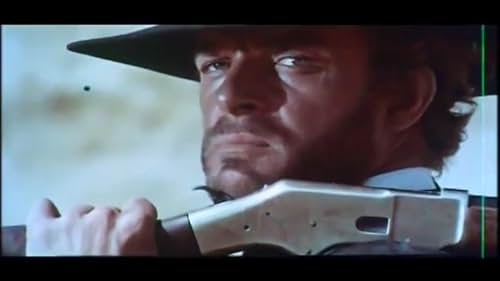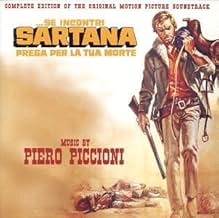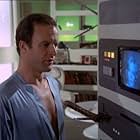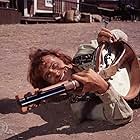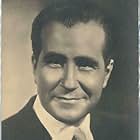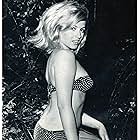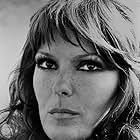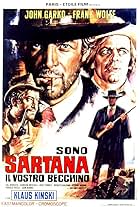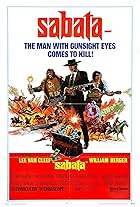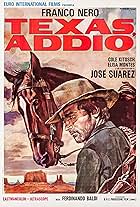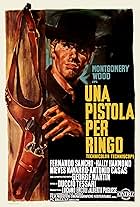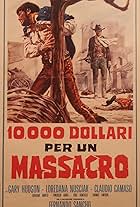... If You Meet Sartana Pray for Your Death.
Original title: Se incontri Sartana prega per la tua morte
IMDb RATING
6.3/10
2K
YOUR RATING
A gadget-laden gunfighter and gambler interferes with the complex schemes of gangsters and dignitaries hoping to steal a bank's gold and obtain the insurance payout for its theft.A gadget-laden gunfighter and gambler interferes with the complex schemes of gangsters and dignitaries hoping to steal a bank's gold and obtain the insurance payout for its theft.A gadget-laden gunfighter and gambler interferes with the complex schemes of gangsters and dignitaries hoping to steal a bank's gold and obtain the insurance payout for its theft.
- Awards
- 1 nomination
Gianni Garko
- Sartana
- (as John Garko)
Sydney Chaplin
- Jeff Stewal
- (as Sidney Chaplin)
Klaus Kinski
- Morgan
- (as Klaus Kinsky)
Andrea Scotti
- Perdido
- (as Andrew Scott)
Gianfranco Parolini
- Gambler
- (as J. Francis Littlewords)
Rossella Bergamonti
- Meggie Sam - Stagecoach Passenger
- (as Patricia Carr)
Storyline
Did you know
- TriviaOn the Norwegian cover of the VHS tape, it does not have the name of the main star, Gianni Garko. Only the names of the co-stars Klaus Kinski, Willam Berger and Sidney Chaplin.
- GoofsAt the end of the film, large clouds of dust and hay billow in the street, yet the leaves on the tree in the foreground are perfectly still. The dust and hay are obviously being blown by large fans off-camera.
- ConnectionsFeatured in Denn sie kennen kein Erbarmen - Der Italowestern (2006)
Featured review
Frank Kramer's SARTANA (1968) has emerged as one of the most interesting examples of the classic era Spaghetti Westerns and yet exists as a sort of exuberant failure, reveling in it's sense of artiness & bad taste at the same time. Yet it's an important failure, a movie that spawned a recurring character and helped to shape the Spaghetti Western into a genuinely "adult" form of cinematic entertainment. The film was classified with an "X" certificate in much of Europe when first released and only made it's way to English speaking audiences in a somewhat diminished cut -- and has now been released by indie Spaghetti Western label Wild East Productions on DVD in it's complete form, and demands some re-evaluation. When I first encountered this movie I was admittedly caught up in a wave of excitement about the film's look & style. Here is a pretty much pure example of the Spaghetti Western, made entirely in Italy by an all European cast with no standout Yankee Gringo star turn, unless you count Klaus Kinski's ten minutes or so on screen. Gianni Garko headlines as Sartana in the second of five screen outings by him as a character named "Sartana" but the first from the loosely related series featuring Sartana as a hero: 1966's $1000 ON THE BLACK depicts Sartana as a crazed, barbaric killer and is not related to the Good Guy Sartana movies ... or so the thinking goes.
Sartana's character in this first Good Guy outing is actually more successfully realized than the movie he inhabits, which tells a sort of labyrinthine plot by various bigwigs in a tumbleweed nowhere to intercept a shipment of gold & screw each other over for their percentages, resulting in murder and mayhem: the usual boring stuff. What works is Sartana's character fleshed out by Garko: A black garbed, laconic, mysterious gunfighter who appears out of nowhere with motives all his own and no past history (perhaps the ghost of the original Sartana, sent back to atone for his sins on Earth??). Yet he seems to know what everybody in the movie is up to and has a plan to play the different sides against each other & move in once the dust has settled to pick up the pieces for himself like a Hyena, which is how one character aptly describes him. Sartana is there to preside over the deaths, and make sure everyone gets buried in style.
This is done with a minimum of dialog, an emphasis on mood and a staggering body count for a movie of such limited scope. Which plays out very much like an arty, dark-toned cartoon or graphic novel, with Sartana as a sort of Batman like avenger who takes justice into his own hands. Garko wears his Sartana personal like a tailored suit, even perfecting a way of turning while gazing up from underneath the brim of a hat that reminds me of watching a cobra moving with a snake charmer. He also has more in common with James Bond than Clint Eastwood, armed with a small pepper-box type Derringer pistol that behaves more like a movie prop than an actual weapon, and more often then not scheming his way out of a jam or around his adversary's flanks. He is the epitome of "cool" as a Spaghetti Western anti-hero, and it is easy to see why his performance spawned a series.
The film also boasts a first rate A-list supporting cast of genre veterans: the crazed William Berger, Sydney Chaplin, Spaghetti Western legend Fernando Sancho, Andrea Scotti, Sal Borgese, and of course Klaus Kinski. One of the attributes that gives the film a decidedly surrealist bent is Kinski's "performance", which appears to have been filmed over the course of a long weekend without anyone else present on set but Kinski. Watch him in the barbershop scene: He appears to be dialing it in from another dimension, and in all is on-screen for about ten minutes. What a way to make a living. The later "Sartana" movies directed by Anthony Ascott became increasingly cartoonish but this film has a dark, nasty, almost sadistic side to it that is quite special. I would almost refer to it as "mean spirited", and filmed on a shoestring budget that allowed no quarter for artifice. The offbeat musical score by Piero Piccioni is uniquely un-cinematic with an organ as the central instrument instead of the usual Morricone flavored bravado, and most of the outdoor scenes were filmed near a dump outside of Rome. You can see the green yucky chemicals polluting the pond around which one scene is set, which seems appropriate for a ghoulish, overtly violent cartoon. Or even a horror movie.
8/10 for Spaghetti fans, 5/10 for everybody else, and a classic of the genre any way you slice it.
Sartana's character in this first Good Guy outing is actually more successfully realized than the movie he inhabits, which tells a sort of labyrinthine plot by various bigwigs in a tumbleweed nowhere to intercept a shipment of gold & screw each other over for their percentages, resulting in murder and mayhem: the usual boring stuff. What works is Sartana's character fleshed out by Garko: A black garbed, laconic, mysterious gunfighter who appears out of nowhere with motives all his own and no past history (perhaps the ghost of the original Sartana, sent back to atone for his sins on Earth??). Yet he seems to know what everybody in the movie is up to and has a plan to play the different sides against each other & move in once the dust has settled to pick up the pieces for himself like a Hyena, which is how one character aptly describes him. Sartana is there to preside over the deaths, and make sure everyone gets buried in style.
This is done with a minimum of dialog, an emphasis on mood and a staggering body count for a movie of such limited scope. Which plays out very much like an arty, dark-toned cartoon or graphic novel, with Sartana as a sort of Batman like avenger who takes justice into his own hands. Garko wears his Sartana personal like a tailored suit, even perfecting a way of turning while gazing up from underneath the brim of a hat that reminds me of watching a cobra moving with a snake charmer. He also has more in common with James Bond than Clint Eastwood, armed with a small pepper-box type Derringer pistol that behaves more like a movie prop than an actual weapon, and more often then not scheming his way out of a jam or around his adversary's flanks. He is the epitome of "cool" as a Spaghetti Western anti-hero, and it is easy to see why his performance spawned a series.
The film also boasts a first rate A-list supporting cast of genre veterans: the crazed William Berger, Sydney Chaplin, Spaghetti Western legend Fernando Sancho, Andrea Scotti, Sal Borgese, and of course Klaus Kinski. One of the attributes that gives the film a decidedly surrealist bent is Kinski's "performance", which appears to have been filmed over the course of a long weekend without anyone else present on set but Kinski. Watch him in the barbershop scene: He appears to be dialing it in from another dimension, and in all is on-screen for about ten minutes. What a way to make a living. The later "Sartana" movies directed by Anthony Ascott became increasingly cartoonish but this film has a dark, nasty, almost sadistic side to it that is quite special. I would almost refer to it as "mean spirited", and filmed on a shoestring budget that allowed no quarter for artifice. The offbeat musical score by Piero Piccioni is uniquely un-cinematic with an organ as the central instrument instead of the usual Morricone flavored bravado, and most of the outdoor scenes were filmed near a dump outside of Rome. You can see the green yucky chemicals polluting the pond around which one scene is set, which seems appropriate for a ghoulish, overtly violent cartoon. Or even a horror movie.
8/10 for Spaghetti fans, 5/10 for everybody else, and a classic of the genre any way you slice it.
- Steve_Nyland
- May 14, 2005
- Permalink
- How long is ... If You Meet Sartana Pray for Your Death.?Powered by Alexa
Details
Box office
- Budget
- ITL 137,000,000 (estimated)
- Runtime1 hour 35 minutes
- Sound mix
- Aspect ratio
- 1.85 : 1
Contribute to this page
Suggest an edit or add missing content

Top Gap
By what name was ... If You Meet Sartana Pray for Your Death. (1968) officially released in India in English?
Answer
